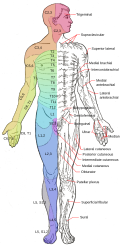User:OJbox/sandbox
Cauda Equina Syndrome
[edit]Symptoms
[edit]Low back pain is a very common disorder; however when discussing cauda equina syndrome, it is important to look in more details of pain. Early diagnosis and treatment is required to prevent any permanent issues. Symptoms of CES range in intensity and onset, but may include more than one symptom. The first sign begins with severe low back pain. Pain, numbness, or weakness radiating down unilaterally or bilaterally are other big signs of CES. The pain can be localized. The disorder greatly affects the lower extremities of the body. Severe problems may progress and leads to loss of sensation between the legs, over the buttocks, inner and back of the legs, and feet. [1] The reflexes of the lower extremity may be reduced or absent depending on where the nerve roots is damaged. This symptom may affect the person’s average daily living as it may make it difficult for them to walk. Another big alert of CES is if the patient is having a urinary or bowel dysfunction. Urinary or bowel dysfunction leads to impacted feces which may lead to infections or compression of the pelvic nerve. [2] They may have difficulty controlling their urination and or loss of rectal control. [3].
Haverbush, Thomas J.[4] noted the condition can be separated into three groups with regard to onset. Group 1 is described as the symptom arised suddenly without any previous history of back pain of the patient. Group 2 is described as a patient with a previous history of low back pain and a sudden difficulty of urinating. Group 3 is described as CES occurred gradually from a history of low back pain and sciatica pain. [5]

Diagnosis
[edit]Diagnosing CES is difficult as the signs are very similar to other disorders. The pain can be overlooked and be evaluated as just low back pain. Diagnosing begins with a physical examination. The examination will assess for strength, reflexes, stability, alignment, and motion of the patient. Rectal examination is a common examination in determining CES; however in an experiment conducted by Gooding et al [6] , the study confirms rectal examination has no significant value in acute diagnosis of cauda equina syndrome. The examination will test for peripheral sensation and anal sphincter tone. A residual will be obtained and tested for urinary retention. Domen et al (2009)[7] concluded that urinary retention of more than 500 ml is an important predictor of cauda equine compression as confirmed by a magnetic resonance imaging (MRI) scan. Testing the anal sphincter, the sphincter tone is diminished. [8]
Besides physical signs of the symptom, another indication of the syndrome is through analyzing scans. There are several scans that can be performed in evaluating the nerve roots such as MRI or CT scan, which will allow a 3d dimensional image of the spine. A myelogram can be performed; a dye is injected into the subarachnoid space with a needle. The x- ray picks up contrast of the spine in order to determine and isolate exactly where there is pressure on the nerve or spinal cord.

- ^ 1. "Cauda Equina Syndrome-OrthoInfo - AAOS." Cauda Equina Syndrome-OrthoInfo - AAOS. American Ortheopaedic Surgeons, 2007. Web. 21 Apr. 2013.
- ^ 6. Lawrentschuk, Nathan, and Hung Nguyen. "Cauda Equina Syndrome Secondary To Constipation: An Uncommon Occurrence." ANZ Journal Of Surgery 75.6 (2005): 498-500. Academic Search Premier. Web. 13 May 2013.
- ^ 8. Villavicencio, Alan. "Cauda Equina Syndrome." Spine-health. Spine Health, n.d. Web. 21 Apr. 2013.
- ^ 5. Haverbush, Thomas J. "Cauda Equina Syndrome." Online Orthopaedics. Joe Carulli, 2012. Web. 21 Apr. 2013.
- ^ 5. Haverbush, Thomas J. "Cauda Equina Syndrome." Online Orthopaedics. Joe Carulli, 2012. Web. 21 Apr. 2013.
- ^ 4. Gooding, Benjamin W. T., Mark A. Higgins, and Denis A. D. Calthorpe. "Does Rectal Examination Have Any Value In The Clinical Diagnosis Of Cauda Equina Syndrome?." British Journal Of Neurosurgery 27.2 (2013): 156-159. Academic Search Premier. Web. 13 May 2013.
- ^ 3. Domen PM, Hofmanb PA, Van Santbrinkc H, Weber WEJ (2009) Predictive Value of clinical characteristics in patients with suspected cauda equine syndrome. Eur J Neurol 16 (3): 416–9
- ^ 7. Small, S., A. Perron, and W. Brady. "Orthopedic Pitfalls: Cauda Equina Syndrome." The American Journal of Emergency Medicine 23.2 (2005): 159-63. Pubmed. Web. 20 Apr. 2013. <http://www.ncbi.nlm.nih.gov/pubmed/15765336>.

